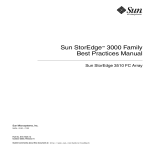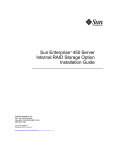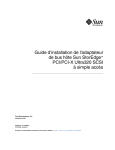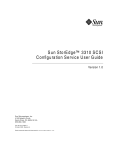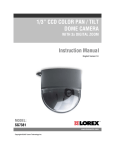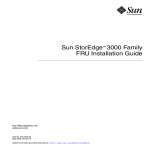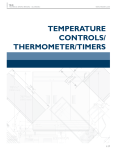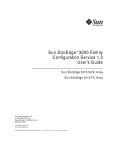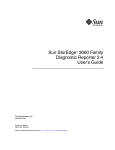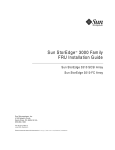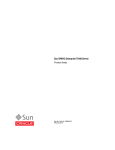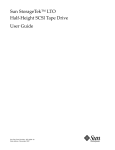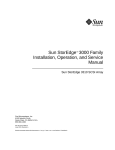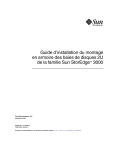Download Sun StorEdge 3310 SCSI Array Release Notes
Transcript
Sun StorEdge™ 3310 SCSI Array Release Notes Sun Microsystems, Inc. www.sun.com Part No. 819-7109-10 September 2007, Revision A Submit comments about this document at: http://www.sun.com/hwdocs/feedback Copyright © 2002–2007 Dot Hill Systems Corporation and others, 2200 Faraday Avenue, Suite 100, Carlsbad, California 92008, USA. All rights reserved. All rights reserved. Sun Microsystems, Inc. and Dot Hill Systems Corporation may have intellectual property rights relating to technology embodied in this product or document. In particular, and without limitation, these intellectual property rights may include one or more of the U.S. patents listed at http://www.sun.com/patents and one or more additional patents or pending patent applications in the U.S. and other countries. This product or document is distributed under licenses restricting its use, copying distribution, and decompilation. No part of this product or document may be reproduced in any form by any means without prior written authorization of Sun and its licensors, if any. Third-party software is copyrighted and licensed from Sun suppliers. Parts of the product may be derived from Berkeley BSD systems, licensed from the University of California. UNIX is a registered trademark in the U.S. and in other countries, exclusively licensed through X/Open Company, Ltd. Sun, Sun Microsystems, the Sun logo, Sun StorEdge, Sun StorageTek, Sun Blade, Sun Cluster, Sun Fire, AnswerBook2, docs.sun.com, Netra, Ultra, and Solaris are trademarks or registered trademarks of Sun Microsystems, Inc. in the U.S. and in other countries. U.S. Government Rights—Commercial use. Government users are subject to the Sun Microsystems, Inc. standard license agreement and applicable provisions of the FAR and its supplements. DOCUMENTATION IS PROVIDED “AS IS” AND ALL EXPRESS OR IMPLIED CONDITIONS, REPRESENTATIONS AND WARRANTIES, INCLUDING ANY IMPLIED WARRANTY OF MERCHANTABILITY, FITNESS FOR A PARTICULAR PURPOSE OR NONINFRINGEMENT, ARE DISCLAIMED, EXCEPT TO THE EXTENT THAT SUCH DISCLAIMERS ARE HELD TO BE LEGALLY INVALID. Copyright © 2002–2007 Dot Hill Systems Corporation and others, 2200 Faraday Avenue, Suite 100, Carlsbad, California 92008, Etats-Unis. Tous droits réservés. Sun Microsystems, Inc. et Dot Hill Systems Corporation peuvent avoir les droits de propriété intellectuels relatants à la technologie incorporée dans le produit qui est décrit dans ce document. En particulier, et sans la limitation, ces droits de propriété intellectuels peuvent inclure un ou plus des brevets américains énumérés à http://www.sun.com/patents et un ou les brevets plus supplémentaires ou les applications de brevet en attente dans les Etats-Unis et dans les autres pays. Ce produit ou document est protégé par un copyright et distribué avec des licences qui en restreignent l’utilisation, la copie, la distribution, et la décompilation. Aucune partie de ce produit ou document ne peut être reproduite sous aucune forme, par quelque moyen que ce soit, sans l'autorisation préalable et écrite de Sun et de ses bailleurs de licence, s’il y en a. Le logiciel détenu par des tiers, et qui comprend la technologie relative aux polices de caractères, est protégé par un copyright et licencié par des fournisseurs de Sun. Des parties de ce produit pourront être dérivées des systèmes Berkeley BSD licenciés par l’Université de Californie. UNIX est une marque déposée aux Etats-Unis et dans d’autres pays et licenciée exclusivement par X/Open Company, Ltd. Sun, Sun Microsystems, le logo Sun, Sun StorEdge, Sun Blade, Sun Cluster, Sun Fire, AnswerBook2, docs.sun.com, Netra, Ultra, et Solaris sont des marques de fabrique ou des marques déposées de Sun Microsystems, Inc. aux Etats-Unis et dans d’autres pays. LA DOCUMENTATION EST FOURNIE “EN L’ÉTAT” ET TOUTES AUTRES CONDITIONS, DECLARATIONS ET GARANTIES EXPRESSES OU TACITES SONT FORMELLEMENT EXCLUES, DANS LA MESURE AUTORISEE PAR LA LOI APPLICABLE, Y COMPRIS NOTAMMENT TOUTE GARANTIE IMPLICITE RELATIVE A LA QUALITE MARCHANDE, A L'APTITUDE A UNE UTILISATION PARTICULIERE OU A L’ABSENCE DE CONTREFAÇON. Contents New Features in This Release 1 New Instructions for Migrating From RAID Controller Firmware 3.2x to 4.2 2 Current NVRAM Version Displayed 2 New Clear Core Dump Menu Option in Firmware 2 Mixing Sun StorEdge 3320 and 3310 Controllers and Expansion Units 3 Previous Feature Changes in 4.1x RAID Controller Firmware and 2.x Software Performance Implications of Migrating to Firmware Version 4.x Optimization Mode and Stripe Size Features 7 Obtaining Current Software and Documentation 8 Release Documentation 9 Supported Operating Systems and Software Java Runtime Environment Requirements 10 10 Enabling a Solaris Host to Recognize New Devices and LUNs Supported Connection Methods and Host Adapters 13 Supported Sun Platforms and Connection Methods 14 11 18 Supported Disk Drives Supported Cables 5 9 Service Contact Information Supported Cabinets 3 19 20 iii Network Connectivity Standard Practices 20 Configuring Sun Fire V20z, V40z, V60x, and V65x Servers to Support JBODs (Linux and Windows) 21 Modifications for Sun Fire V20z, V40z,V60x, and V65x Systems Running Red Hat AS 2.1 or 3.0 22 Modifications for Sun Fire V440 Systems Bootability 22 23 Required Patches 24 Installing Required Solaris Patches 24 Upgrading to Software Version 2.4 and Controller Firmware Version 4.2 Downloading and Installing Software Applications Downloading and Installing Firmware 25 29 Downloading the VERITAS Volume Manager Array Support Libraries Known Issues 32 Documentation Errata 33 Limitation Using WYSE Terminals iv 33 Sun StorEdge 3310 SCSI Array Release Notes • September 2007 25 31 Sun StorEdge 3310 SCSI Array Release Notes This document contains important information about the Sun StorEdge™ 3310 SCSI array that was not available at the time the product documentation was published. Read this document so that you are aware of issues or requirements that can impact the installation and operation of the Sun StorEdge 3310 SCSI array. Read this document so that you are aware of issues or requirements that can impact the installation and operation of the Sun StorEdge 3510 FC array and the Sun StorEdge 3511 SATA array. See “Upgrading to Software Version 2.4 and Controller Firmware Version 4.2” on page 25 for information about downloading and installing the firmware package that contains the README file and other supplemental information. New Features in This Release This release includes new versions of RAID controller firmware and related enclosure firmware, Sun StorEdge Configuration Service, Sun StorEdge CommandLine Interface (CLI), and Sun StorEdge Diagnostic Reporter. It incorporates requested enhancements as well as fixes to previously known issues. Note – The Sun StorEdge 3000 Family of storage products, including the Sun StorEdge 3510 FC array and the Sun StorEdge 3511 SATA array, are now often referred to as Sun StorageTek storage products. These are identical products. To avoid confusion, the manuals for these products will retain the old Sun StorEdge designation. 1 New Instructions for Migrating From RAID Controller Firmware 3.2x to 4.2 The RAID controller firmware upgrade procedure has been streamlined and simplified, and additional logging capabilities have been added to the upgrade script. Refer to the Sun StorEdge 3000 Family RAID Controller Firmware Migration Guide, 819-6573 for step-by-step procedures for upgrading RAID controller firmware version 3.2x to version 4.x. Caution – These procedures must be followed when performing this major upgrade. Minor upgrades from earlier versions of 4.1x firmware do not require the use of this document and can be performed by following the instructions in the firmware patch README file. Current NVRAM Version Displayed The RAID controller’s firmware now displays the current NVRAM version installed on the controller in the View System Information window. This helps diagnose any conflicts that might have occurred if a controller was replaced or new firmware installed without resetting NVRAM. Refer to the Sun StorEdge 3000 Family RAID Firmware 4.2 User’s Guide, 817-3711-17 for instructions on how to use this feature. Note – The RAID controller firmware’s Main Menu must be used to display the current NVRAM version information; it is not yet presented in the Sun StorEdge Configuration Service or Sun StorEdge CLI interfaces. New Clear Core Dump Menu Option in Firmware If an unrecoverable error condition occurs, the affected controller might write debug information to NVRAM. If this happens, an event message will be displayed each time the controller reboots, such as the following: ALERT: Controller Unrecoverable Error 0001 00000000 00000000 45754677 2 Sun StorEdge 3310 SCSI Array Release Notes • September 2007 To clear this event, from the firmware Main Menu, first record the event message in case you need to inform support personnel, and then choose system Functions → Controller Maintenance → Clear core dump. Otherwise, the message recurs each time you reboot. Mixing Sun StorEdge 3320 and 3310 Controllers and Expansion Units Connecting Sun StorEdge 3320 expansion units to Sun StorEdge 3310 RAID controllers is supported, but the Sun StorEdge 3320 drives will only perform at U160 speeds rather than U320 speeds. However, connecting a Sun StorEdge 3310 expansion unit to a Sun StorEdge 3320 RAID controller is not supported. Previous Feature Changes in 4.1x RAID Controller Firmware and 2.x Software A number of firmware and software changes occurred when RAID controller firmware 4.11 was introduced; they apply to all firmware 4.x versions. TABLE 1 describes these changes. TABLE 1 Summary of Sun StorEdge 3000 Family 4.1x Firmware and 2.x Software Features Feature Description Default IP address assigned by a DHCP server By default, each chassis has an IP address assigned to it if your network uses a Dynamic Host Configuration Protocol (DHCP) server to automatically allocate IP addresses to attached devices. You can then access that IP address through the Sun StorEdge CLI, Sun StorEdge Configuration Service, or the firmware application. If you do not use a DHCP server and therefore have no IP address, you can set an IP address through serial connection to the firmware. Logical Drive Capacity The firmware allows up to 64 TB per logical drive configuration with sequential optimization and up to 16 TB per logical drive configuration with random optimization. These limits are further modified by available drive sizes and the maximum number of drives allowed per product. Number of Logical Drives You can configure up to 32 logical drives per configuration, with a maximum of 32 partitions per logical drive. Sun StorEdge 3310 SCSI Array Release Notes 3 TABLE 1 Summary of Sun StorEdge 3000 Family 4.1x Firmware and 2.x Software Features (Continued) Feature Description Configurable Parameters per Logical Drive You can configure stripe size and write (cache) policy individually for each logical drive with a maximum limit of 1024 LUNs. Optimization Mode and Stripe Size This optimization mode applies to cache optimization, rather than stripe size. You can fine-tune performance by setting the most desirable stripe size for each logical drive to best match the application of that logical drive. For more information, see “Optimization Mode and Stripe Size Features” on page 7. Media Scan The media scan feature sequentially checks each physical drive in a selected logical drive, block by block, for bad blocks. If a bad block is encountered, the controller rebuilds the data from the bad block onto a good block if one is available on the physical drive. If no good blocks are available on the physical drive, the controller designates the physical drive “Bad,” generates an event message, and if a spare drive is available, will begin rebuilding data from the bad physical drive onto the spare. The media scan feature generates informational event messages for each drive that is part of a logical drive. The informational event messages are also generated each time a controller is reset or a logical drive is created. During the media scan, the green front-panel LEDs blink rapidly for every active drive comprising the logical drive. After upgrading from 4.1x to 4.2, an array reset is necessary for the new media scan default to take effect and automatic media scanning to stop. SNMP Traps Similar to Sun StorEdge Configuration Service, the controller firmware can send SNMP traps to an SNMP management console, send email messages, and broadcast events to specified servers, as defined in a text file called agent.ini. Network Protocol Access For security reasons, you can restrict the network protocols you want to support, which limits access. Protocol access that can be enabled or disabled includes telnet, HTTP, HTTPS, FTP, SSH, PriAgentAll, SNMP, DHCP, and ping. Telnet Inactivity Timeout Time Set this security measure so that any telnet connection automatically disconnects after the connection has been idle for a configurable period of time. The current setting is displayed with the menu option. Online Initialization and Online Expansion Enabling Online Initialization or Online Expansion enables you to use the logical drive while it is being initialized or expanded. However, the completion of the initialization or expansion takes longer than if these processes are run while the logical drives are not in use. Logical and Physical Drive Safeguards There are safeguards against combining physical drives of different types in logical drives, with accompanying explanatory error messages. 4 Sun StorEdge 3310 SCSI Array Release Notes • September 2007 TABLE 1 Summary of Sun StorEdge 3000 Family 4.1x Firmware and 2.x Software Features (Continued) Feature Description Fault-Management Safeguards Automatically switch to write-through cache mode based on: • Low battery level • AC power loss • Fan failure • Power supply failure • High temperature in CPU/Enclosure • Failure of a redundant controller • Single-controller configuration • Automatic system shutdown based on critical environmental conditions Ethernet and RS-232 Security For added security, a password can be supplied for access to the array using a telnet session or tip session. If a password has not been established, pressing the RETURN key enables access to the firmware menu. CLI Status Commands The CLI set led and show led-status commands are supported on Sun StorEdge 3320, Sun StorEdge 3510 FC, Sun StorEdge 3511 SATA RAID arrays, and JBODs connected to RAIDs. SMART Feature Enabled by Default The Self-Monitoring, Analysis and Reporting Technology (SMART) feature is enabled by default in the firmware, with the Detect and Clone+Replace option turned on. Default Configuration Parameter Settings A number of default settings have changed to reflect various firmware changes. If you are upgrading from 3.2x to 4.2 firmware, these new defaults are applied once you reset NVRAM. Upgrading Controller Firmware from 4.1x When upgrading controller firmware from an earlier version of 4.1x, the Drive Predictable Failure Mode (SMART) will be set to 'Detect only' by default if the prior setting was 'Disabled.' The recommended setting is 'Detect and Clone+Replace' and must be set manually after the upgrade is complete. Note – After upgrading from 4.1x to 4.2, an array reset is necessary for the new media scan default to take effect and automatic media scanning to stop. Performance Implications of Migrating to Firmware Version 4.x Sun has made changes to the firmware for the StorEdge 3310 and 351x arrays between versions 3.2x and 4.x that can impact performance. The algorithm for aggregating small writes in the cache has been improved so that they can be written to disk at the same time. This results in improved performance under workloads that Sun StorEdge 3310 SCSI Array Release Notes 5 issue mostly small sequential writes, or many small random writes within the same region. The performance improvement is most dramatic under workloads that queue many commands to the array, giving it the most opportunities to aggregate writes. Users should tune their applications and host driver stacks to queue up to 32 commands whenever possible. Sun has also added increased error and data integrity checking to firmware 4.11 and later versions that can have an adverse affect on performance for StorEdge 33x0 and 351x arrays when upgrading from firmware version 3.2x. Users might experience a decrease in performance under workloads that primarily issue sequential reads. To mitigate this impact, tune applications and host driver stacks to issue the largest reads and maintain the highest queue depths possible. Users may also see a small performance decrease under workloads that primarily issue large sequential writes. These users should also tune their host to issue the largest writes possible and maintain a large command queue depth. Note – Choosing sequential optimization, the default, almost always results in better performance than choosing random optimization, even if random optimization performed better for your configurations and applications in firmware versions 3.x. See “Optimization Mode and Stripe Size Features” on page 7 for explanatory details. Firmware and software changes between 4.15 and 4.21 have no significant impact on performance. Using cache write-through mode rather than write-back mode can have a significant impact on performance. To ensure that write-back cache is enabled for all LUNs after upgrading RAID controller firmware, from the RAID controller firmware Main Menu choose “view and edit Configuration parameters > Caching Parameters > write-back cache.” If it is disabled, choose 'Yes' to change the setting to Enabled. Additional safety checks have been added to the 4.x firmware that will disable writeback cache and change the cache to write-through mode under certain error conditions. Conditions that can cause the array to switch to write-through mode include: ■ ■ ■ ■ ■ ■ Battery backup failure AC power loss Fan failure Power supply failure High temperature in CPU/Enclosure Failure of a redundant controller Once the condition is corrected, write-back cache is automatically re-enabled. 6 Sun StorEdge 3310 SCSI Array Release Notes • September 2007 In firmware versions 4.11 and later, these triggering events can be enabled or disabled, and the threshold limits can be set, using the RAID controller firmware’s Main Menu. For more information about write-back cache, refer to Chapter 11, “Configuration Parameters,” in the Sun StorEdge 3000 Family RAID Firmware 4.2 User's Guide. Optimization Mode and Stripe Size Features The optimization mode in firmware version 4.x controls cache block size only. This is a significant improvement in functionality and performance over earlier 3.x firmware, where the optimization mode chosen also determined stripe size for all logical drives. With firmware version 4.x, when you specify sequential or random cache optimization, the controller determines and specifies a default stripe size for newlycreated logical drives. However, you can specify a stripe size for each logical drive when you create it, enabling you to maximize performance by matching stripe size with your application requirements. Since different applications can use different logical drives, this functionality provides you with greatly increased flexibility. Because of this, sequential optimization, which is the default, is almost always the best optimization choice. You should use random optimization only when performance testing in your production environment demonstrates improvement over the default sequential optimization. For sequential optimization, the cache block size is 128 Kbyte. Available stripe size options include 16 Kbyte, 32 Kbyte, 64 Kbyte, 128 Kbyte, and 256 Kbyte. The default stripe size for sequential optimization is 128 Kbyte for all logical drives except RAID 3, which is 16 Kbyte. For random optimization, the cache block size is 32 Kbyte. Available stripe size options include 4 Kbyte, 8 Kbyte, 16 Kbyte, 32 Kbyte, 64 Kbyte, 128 Kbyte, and 256 Kbyte. The default stripe size for random optimization is 32 Kbyte for all logical drives except RAID 3, which is 4 Kbyte. With firmware version 4.x, you can also specify a cache write policy for each individual logical drive, giving you further opportunities for performance tuning. Sun StorEdge 3310 SCSI Array Release Notes 7 The following table summarizes the functionality described above: TABLE 2 Summary of Optimization and Stripe Size Features Feature Description Sequential or Random Cache Optimization Mode Sets block size for cache in a chassis. Stripe size for each logical drive is userselectable, but optimization mode determines default stripe size. Use the default sequential optimization unless real-world tests in your production environment show better results using random optimization. Changing the optimization mode To change the optimization mode without deleting logical drives, use the Sun StorEdge CLI set cache-parameters command. Stripe Size Using the controller firmware, you can now specify an appropriate stripe size for each logical drive when you create it. Changing the stripe size To change the stripe size of an individual logical drive, delete the logical drive and create a new logical drive with the desired stripe size. Cache Write Policy Specify a write-back or write-through cache policy for the entire RAID array. Specify a default write-back, or write-through policy for each logical drive. Specify event triggers that switch cache policy from write-back to writethrough when specific environmental events occur, and switch back when the condition is rectified. Obtaining Current Software and Documentation A CD-ROM containing Sun StorEdge Configuration Service and Diagnostic Reporter software, installation and configuration documents, along with Sun StorEdge 3000 family documentation, is not automatically shipped with the Sun StorEdge 3120, 3310, 3320, 3510, and 3511 products. Contact your Sun sales representative if you need these contents made available on a CD-ROM. The most recent versions of software previously shipped on CD are available by clicking the “StorageTek 3000 Family Storage Products--Related Software V 2.3 General Availability” link on this Sun Download Center page: http://www.sun.com/software/download/ You can download the related hardware and software documentation by clicking the appropriate Sun StorageTek 3xxx Array link on Sun Microsystems Documentation’s Workgroup Storage web page: http://docs.sun.com/app/docs/prod/wkgrp.disk 8 Sun StorEdge 3310 SCSI Array Release Notes • September 2007 Release Documentation These release notes supplement the documents shown in TABLE 3. TABLE 3 Sun StorEdge 3310 SCSI Array Documentation Title Part Number Sun StorEdge 3000 Family Installation, Operation, and Service Manual 816-7290 Sun StorEdge 3000 Family Best Practices Manual: Sun StorEdge 3310 and 3320 SCSI Arrays 819-1275 Sun StorEdge 3000 Family RAID Controller Firmware Migration Guide 819-6573 Sun StorEdge 3000 Family FRU Installation Guide 816-7326 Sun StorEdge 3000 Family Rack Installation Guide for 2U Arrays 819-4026 Sun StorEdge 3000 Family RAID Firmware 4.2 User’s Guide 817-3711 Sun StorEdge 3000 Family 2.4 Software Installation Guide 817-3764 Sun StorEdge 3000 Family Configuration Service 2.4 User’s Guide 817-3337 Sun StorEdge 3000 Family Diagnostic Reporter 2.4 User’s Guide 817-3338 Sun StorEdge 3000 Family CLI 2.4 User’s Guide 817-4951 Sun StorEdge 3000 Family Safety, Regulatory, and Compliance Manual 816-7930 Service Contact Information If you need help installing or using this product, call 1-800-USA-4SUN, or go to: http://www.sun.com/service/contacting Sun StorEdge 3310 SCSI Array Release Notes 9 Supported Operating Systems and Software The supported operating systems are: ■ Solaris 8, 9, and 10 operating systems, SPARC Platform Edition ■ Solaris 10 operating systems, x86 Platform Edition ■ Red Hat Linux AS 2.1, 3.0, and 4.0 ■ Microsoft Windows 2003 Server operating systems ■ IBM AIX 5.1, 5.2, and 5.3 ■ HP-UX 11i operating systems ■ Novell Netware 5.1, 6.0, and 6.5 ■ SUSE Linux Enterprise Server 9.0, (32-bit and 64-bit) Supported Sun Enterprise and application software includes: ■ Sun StorEdge 3000 Family Configuration Service 2.4 software ■ Sun StorEdge 3000 Family Diagnostic Reporter 2.4 software ■ Sun StorEdge 3000 Family CLI 2.4 software ■ Sun Storage Automated Diagnostic Environment (StorADE) 2.4 software ■ Solstice DiskSuite 4.2.1 or greater (for the Solaris 8 operating system) ■ Solaris Volume Manager (for the Solaris 9 operating system and above) ■ VERITAS Volume Manager 3.5, 4.0, 4.1, and 5.0. See “Downloading the VERITAS Volume Manager Array Support Libraries” on page 31 for a description of how to obtain an Array Software Library (ASL) that enables the VERITAS software to work with the Sun StorEdge 3310 SCSI array. ■ Sun StorEdge Performance Suite (with Sun StorEdge QFS software) ■ Sun StorEdge Availability Suite ■ Sun StorEdge Utilization Suite (with Sun StorEdge SAM-FS software) Java Runtime Environment Requirements Before you install Sun StorEdge Configuration Service, Sun StorEdge Diagnostic Reporter, or the Sun StorEdge CLI, make sure that your system meets the Java Runtime Environment (JRE) prerequisites shown in the Sun StorEdge 3000 Family 10 Sun StorEdge 3310 SCSI Array Release Notes • September 2007 Software Installation Guide instructions for your operating system. In general, you can use Sun JRE version 1.2.2 or later for all platforms. IBM AIX and SUSE Linux can also use IBM JRE version 1.2 or later. Enabling a Solaris Host to Recognize New Devices and LUNs By default, a Solaris host is configured for one host LUN per SCSI target, which is insufficient for a Sun StorEdge 3310 SCSI array. You must edit the appropriate onboard HBA driver configuration file to add more targets and LUNs, up to 32 LUNs per logical drive, and a maximum of 128 LUNs per Sun StorEdge 3310 SCSI array. Driver configuration files include /kernel/drv/qus.conf, /kernel/drv/mpt.conf, and /kernel/drv/glm.conf. Edit the file which is appropriate for your HBA. Caution – Do not edit the /etc/system file to accomplish the same purpose. While this can have the desired effect, it can also cause interference with other storage devices attached to the same host. Note – Refer to the driver.conf(4) man page for information and syntax to use. Refer to your HBA release notes and your HBA installation guide for specific configuration information. Once you have edited the configuration file, reboot the host for the changes to take effect. 1. Edit the /kernel/drv/qus.conf, /kernel/drv/glm.conf, or /kernel/drv/mpt.conf file (whichever is appropriate to your HBA) to add more targets and LUNs (up to 32 LUNs per logical drive, and a maximum of 128 LUNs per Sun StorEdge 3310 array). Note – If the file does not exist, create it using the format shown in the following examples. Allow five blank spaces between “Sun” and “StorEdge” on the first line. In an environment where only Sun StorEdge 3310 SCSI devices are used, an example of text to add to /kernel/drv/qus.conf, /kernel/drv/glm.conf, or /kernel/drv/mpt.conf is: Sun StorEdge 3310 SCSI Array Release Notes 11 device-type-scsi-options-list = “SUN “SE3310-scsi-options”; SE3310-scsi-options = hexadecimal address; StorEdge 3310”, In an environment where both Sun StorEdge 3310 and 3320 SCSI devices are used, an example of text to add to /kernel/drv/qus.conf, /kernel/drv/glm.conf, or /kernel/drv/mpt.conf is: device-type-scsi-options-list = "SUN StorEdge 3310", "SE33x0-scsi-options", "SUN StorEdge 3320", "SE33x0-scsi-options"; SE33x0-scsi-options = hexadecimal address; For more information about multiple device types, refer to the scsi_get_device_type_scsi_options(9F) man page. 2. Reboot the host to implement the file changes. The Solaris 8 operating system requires a reconfiguration reboot to create device files and implement sd.conf changes, but you do not need a reconfiguration reboot for the Solaris 9 or 10 operating system. reboot -- -r For the Solaris 9 or 10 operating system, use the following commands to create device files after you have edited sd.conf. No reboot is necessary with this command: update_drv -f sd devfsadm The new LUNs are displayed when you perform the format command. 3. To display the new LUNs, perform the following command: format 12 Sun StorEdge 3310 SCSI Array Release Notes • September 2007 Supported Connection Methods and Host Adapters The Sun StorEdge 3310 array can be connected to a host in one of two ways: ■ ■ By means of a supported host adapter By means of a single-ended SCSI controller embedded in a supported host TABLE 4 lists the supported host adapters and connections. TABLE 4 Supported Host Adapters and Connections Operating System Host Adapter Part Number Solaris operating system An on-board SCSI port attachment (on the host system) N/A Solaris operating system Sun StorEdge PCI Dual Ultra3 SCSI host adapter (X)6758A Solaris operating system Dual Ultra2 SCSI and dual FastEthernet PCI adapter (X)2222A Solaris operating system Dual Ultra2 SCSI and dual Gigabit Ethernet PCI adapter (X)4422A Solaris operating system SunSwift adapter (Sun FastEthernet 10/100BaseT F/W UltraSCSI SBus adapter 1.0) (X)1018A Solaris operating system Ultra320 SCSI Dual Channel PCI-X adapter SG-XPCI2SCSILM320 Solaris operating system Ultra320 SCSI Single Channel PCI-X adapter SG-XPCI1SCSILM320 Solaris 9 x86 update 6 and Solaris 10 x86 operating system Ultra320 SCSI Dual Channel PCI-X adapter (throttled down to 160 speed) X9265A LSI22320-R3 Red Hat AS and SUSE Linux Ultra320 SCSI Dual Channel PCI-X adapter (throttled down to 160 speed) X9265A LSI22320-R3 Windows 2000and 2003 Ultra320 SCSI Dual Channel PCI-X adapter X9265A LSI22320-R3 Novell Netware 5.1, 6.0, and 6.5 Adaptec Dual Ultra320 SCSI PCI host adapter Adaptec 39320A-R4 HP-UX operating system HP Ultra 160 SCSI Adapter for SCSI1 A6829A IBM AIX operating system IBM Dual channel PCI Ultra3 SCSI Adapter2 SYM53C1010 1 This HP HBA is officially tested and supported. Equivalent HP HBAs are also supported. 2 This IBM AIX HBA is officially tested and supported. Equivalent AIX HBAs are also supported. 3 The LSI22320-R HBA is not available from Sun. 4 The Adaptec HBA is not available from Sun. Sun StorEdge 3310 SCSI Array Release Notes 13 Caution – If you are using Solaris 8 or Solaris 9 operating systems and if you are using the Sun StorEdge PCI Dual Ultra3 SCSI host adapter (X)6758A, you must download and install the adapter’s driver in the host where the adapter is installed. (Refer to the Sun StorEdge PCI Dual Ultra3 SCSI Host Adapter Release Notes, part number 816-2157, for the download procedure.) Without the driver, any array connected to the adapter is not visible to the host, since this driver is not included in the Solaris operating system. Supported Sun Platforms and Connection Methods TABLE 5 and TABLE 6 show the connection methods supported for each supported Sun server. TABLE 5 Supported Sun SPARC-Based Systems and Connection Methods (X)6758A Host Adapter1 On-Board SCSI Port (X)2222A & (X)4422A (-2) HBAs (X)1018A SBus Adapter SGXPCI2SCSILM320 (-Z) SGXPCI1SCSILM320 (-Z) Sun Java W1100z No No No No No Yes Sun Java W2100z No No No No No Yes Ultra™ 30 workstation No No Yes No No No Ultra 40 workstation No No No No No Yes Ultra 60 workstation Yes Yes Yes No Yes No Ultra 80 workstation Yes Yes Yes No Yes No Sun Blade™ 100 workstation No No Yes No No No Sun Blade 150 workstation No No Yes No Yes No Sun Blade 1000 workstation Yes Yes Yes No Yes No Sun Blade 1500 workstation Yes No Yes No Yes No Sun Blade 2000 workstation Yes Yes Yes No Yes No Sun Blade 2500 workstation Yes Yes Yes No Yes No Netra™ 20 server Yes Yes Yes No Yes No Netra 120 server Yes Yes Yes No Yes No Netra 240 server No No Yes No Yes No 14 2 Sun StorEdge 3310 SCSI Array Release Notes • September 2007 TABLE 5 Supported Sun SPARC-Based Systems and Connection Methods (Continued) (X)6758A Host Adapter1 On-Board SCSI Port (X)2222A & (X)4422A (-2) HBAs (X)1018A SBus Adapter SGXPCI2SCSILM320 (-Z) SGXPCI1SCSILM320 (-Z) Netra 440 server No No Yes No Yes No Netra 1280 server Yes Yes Yes No Yes No Netra AC200 server No No Yes No No No Netra DC200 server No No Yes No No No Netra t 1 server No No Yes No Yes No Netra t 100 server No No No No Yes No Netra t 105 server No No No No Yes No Netra t 1120 server Yes Yes Yes No Yes No Netra t 1125 server Yes Yes Yes No Yes No Netra t 1400 server Yes Yes Yes No Yes No Netra t 1405 server Yes Yes Yes No Yes No Sun Enterprise™ 220R server Yes Yes Yes No Yes No Sun Enterprise 250 server Yes Yes Yes No Yes No Sun Enterprise 420R server Yes Yes Yes No Yes No Sun Enterprise 450 server Yes Yes Yes No Yes No Sun Enterprise 3500 server No Yes No Yes No No Sun Enterprise 4500 server No Yes No Yes No No Sun Enterprise 5500 server No Yes No Yes No No Sun Enterprise 6500 server No Yes No Yes No No Sun Enterprise 10000 server No No Yes/No3 Yes No No Sun Fire™ V20z server No No Yes No Yes Yes Sun Fire V40z server No No Yes No Yes Yes Sun Fire V60x server No No No No Yes No Sun Fire V65x server No No No No Yes No Sun Fire 280R server Yes Yes Yes No Yes No Sun Fire V120 server Yes Yes Yes No Yes No Sun Fire V210 server Yes Yes Yes No Yes No Sun Fire V240 server Yes Yes Yes No Yes No Sun Fire V250 server Yes Yes Yes No Yes No 2 Sun StorEdge 3310 SCSI Array Release Notes 15 TABLE 5 Supported Sun SPARC-Based Systems and Connection Methods (Continued) (X)6758A Host Adapter1 On-Board SCSI Port (X)2222A & (X)4422A (-2) HBAs (X)1018A SBus Adapter SGXPCI2SCSILM320 (-Z) SGXPCI1SCSILM320 (-Z) Sun Fire V440 server Yes Yes Yes No Yes No Sun Fire V480 server Yes No Yes No Yes No Sun Fire V490 server Yes No Yes No Yes No Sun Fire V880 server Yes No Yes No Yes No Sun Fire V890 server Yes No Yes No Yes No Sun Fire V1280 server Yes Yes Yes No Yes No Sun Fire 2900 server Yes Yes Yes No Yes No Sun Fire X4100 server No No No No No Yes Sun Fire X4200 server No No No No No Yes Sun Fire 4800 server Yes No Yes No Yes No Sun Fire 4810 server Yes No Yes No Yes No Sun Fire 4900 server Yes No Yes No Yes No Sun Fire 6800 server Yes No Yes No Yes No Sun Fire 6900 server Yes No Yes No Yes No Sun Fire 12K server Yes No Yes No Yes No Sun Fire 15K server Yes No Yes No Yes No Sun Fire E20K server Yes No Yes No Yes No Sun Fire E25K server Yes No Yes No Yes No Sun Fire E2900 server No No Yes No Yes No Sun Fire T2000 server No No No No No Yes 2 1 No in this column = The HBA in the column heading is not supported on this platform. 2 To enable support for either the Sun StorEdge 3310 SCSI RAID or JBOD arrays using the on-board SCSI port of the Sun Fire V440, see “Modifications for Sun Fire V440 Systems” on page 22. No on-board SCSI port is available on the V480, V880, 4800, 4810, 6800, and E10K servers. 3 (X)2222A is supported. (X)4422A is not supported. Note – To ensure cable and onboard HBA compatibility, review the HBA Sunswift manual for applicable restrictions. 16 Sun StorEdge 3310 SCSI Array Release Notes • September 2007 TABLE 6 Supported Solaris 9 and Solaris 10 Sun x86-Based Systems and Connection Methods Server On-board X9265A LSI22320-R Sun Fire V60x server1 Yes No Sun Fire V65x server Yes No Sun Fire V20z server No Yes Sun Fire V40z server No Yes 1 To change the Ultra320 speed to the Ultra160 speed needed to operate with a 3310 SCSI JBOD array and the X9265A HBA, refer to the following procedure. ▼ To Configure the Sun Fire V60x, Sun Fire V65x, Sun Fire V20Z, and Sun Fire V40z for Ultra160 Speed Perform the following steps to change the Ultra320 speed to the Ultra160 speed needed to operate with a Sun StorEdge 3310 SCSI JBOD array and the X9265A HBA. 1. Edit the mpt.conf file on the Sun x86-based system by creating a /kernel/drv/mpt.conf file with the following lines. name= “mpt” parent=”/pci@1f,700000” unit-address=”2,1” scsi-options=0x1ff8; 2. Reboot the system. Sun StorEdge 3310 SCSI Array Release Notes 17 Supported Cabinets TABLE 7 shows the supported cabinets with their associated rackmount kits and other required kits. Refer to the Sun StorEdge 3000 Family Rack Installation Guide for 2U Arrays for installation instructions. TABLE 7 Supported Cabinets and Associated Rackmount Kits Cabinet Part Number(s) Required Kit(s) Sun StorEdge 72-inch Expansion Cabinet SG-(X)ARY030A Rackmount Kit (X)TA-3000-2URK-19U, (X)TA-3000-2URK-19UZ 14 Sun Fire Cabinet SF-(X)CAB, SFE-(X)CAB Rackmount Kit X)TA-3000-2URK-19U, (X)TA-3000-2URK-19UZ 5 Sun Rack 900-38 Cabinet SR9-(X)KM038A-IP Rackmount Kit X)TA-3000-2URK-19U, (X)TA-3000-2URK-19UZ 18 Sun Rack 1000-38 Cabinet SRK-(X)RS038A-IP Rackmount Kit X)TA-3000-2URK-19U, (X)TA-3000-2URK-19UZ 18 Sun Rack 1000-42 Cabinet SRK-(X)AZ042A-IP Rackmount Kit X)TA-3000-2URK-19U, (X)TA-3000-2URK-19UZ 18 Sun Fire 6800 System F6800-1 Rackmount Kit X)TA-3000-2URK-19U, (X)TA-3000-2URK-19UZ 3 Sun Fire E6900 System E6900-BASE Rackmount Kit X)TA-3000-2URK-19U, (X)TA-3000-2URK-19UZ 2 Standard EIA Cabinets Not Applicable Rackmount Kit X)TA-3000-2URK-19U, (X)TA-3000-2URK-19UZ Varies Telco flushmount racks Not Applicable Telco Front Mount Rackmount Kit XTA-3000-2URK-19F, XTA-3000-2URK-19FZ Varies Telco center-of-gravity racks Not Applicable Telco Center Mount Rackmount Kit XTA-3000-2URK-19C, XTA-3000-2URK-19CZ Varies Cabinet Name Required Kit Part Number Maximum Number of Arrays Supported per Cabinet Note – For more information about using Sun StorEdge arrays with the Sun Rack 900 and 1000 cabinets, refer to the Sun Rack 900 Qualified Products web page at http://www.sun.com/servers/rack/approved.html 18 Sun StorEdge 3310 SCSI Array Release Notes • September 2007 Supported Disk Drives TABLE 8 gives descriptions and part numbers for the disk drives supported with the Sun StorEdge 3310 SCSI array. TABLE 8 Supported Disk Drives Description Part Number 36 GB 10,000 RPM (X)TA-3310-36GB-10K 36 GB 15,000 RPM (X)TA-3310-36GB-15K 73 GB 10,000 RPM (X)TA-3310-73GB-10K 73 GB 15,000 RPM (X)TA-3310-73GB-15K 146 GB 10,000 RPM (X)TA-3310-146GB-10K 146 GB 15,000 RPM (X)TA-3310-146GB-15K 300 GB 10,000 RPM (X)TA-3310-300GB-10K Note – In an array shipped with less than 12 drives, each empty slot in the array contains an air management sled to correctly handle the air flow and heat. Each drive slot requires either a disk drive or an air management sled. Note – Disk drive firmware is provided through Sun disk firmware patches, which include the required download utility. Sun disk firmware patches are separate from the Sun StorEdge 3000 family firmware patches. Refer to the instructions in your disk drive firmware patch. Caution – If you replace a disk drive, the replacement disk drive must have the same or greater capacity than the disk drive that is being replaced. You can mix capacity in the same chassis, but not spindle speed (RPM) on the same bus. For example, you can use 36 Gbyte and 73 Gbyte drives with no performance problems if both are 10K RPM drives. Violating this configuration guideline leads to poor performance. If you are adding a new disk drive, these same configuration guidelines apply. Sun StorEdge 3310 SCSI Array Release Notes 19 Supported Cables TABLE 9 lists the supported SCSI cables. Cables can be ordered using the marketing part numbers in TABLE 9. Note – The manufacturing part numbers supplied in the third column of the table can be checked against the manufacturing part numbers stamped on other cables that you might have in stock to confirm that they are supported. TABLE 9 Supported Cables Cable Type and Length Marketing Part Number RoHS Compliant VHDCI/VHDCI 0.8 m, 68-pin (X)1136A-Z RoHS-6 VHDCI/VHDCI 1.2 m, 68-pin (X)1137A RoHS-6 VHDCI/VHDCI 2 m, 68-pin (X)1138A-Z RoHS-6 VHDCI/VHDCI 4 m, 68-pin (X)3830B-Z RoHS-6 VHDCI/VHDCI 10 m, 68-pin (X)3831B-Z RoHS-6 HD-68/VHDCI, 0.8 m, 68-pin (X)1132A-Z RoHS-6 HD-68/VHDCI, 1.2 m, 68-pin (X)1135A RoHS-6 HD-68/VHDCI, 2 m, 68-pin (X)3832A-Z RoHS-6 HD-68/VHDCI, 4 m, 68-pin (X)3830A-Z RoHS-6 HD-68/VHDCI, 10 m, 68-pin (X)3831A-Z RoHS-6 Note – When you attach the provided SCSI bus cables to the Sun StorEdge 3310 SCSI array or expansion unit, it is important to tighten the cable jack screws with six full clockwise turns prior to powering up the array, to ensure proper operation. Network Connectivity Standard Practices It is extremely important for the proper operation and reliability of the equipment that all network connectivity adhere to Ethernet and facility wiring standards IEEE 802.3 and EIA/TIA 568B. Make sure that the cabling and patch cords for your facilities are up to these specifications, and protect the cables from excessive stress and damage. The best practice, and the one that is recommended by all facilities 20 Sun StorEdge 3310 SCSI Array Release Notes • September 2007 wiring standards, is to test your structured cable system end-to-end with a quality cable test set. Adherence to these practices will help eliminate almost all connectivity issues. Other related standards are ISO/IEC IS 11801 (International), Cenelec EN 50173 (Europe), CSA T529 (Canada), and SAA/SNZ HB27:1996 (Australia and New Zealand). Configuring Sun Fire V20z, V40z, V60x, and V65x Servers to Support JBODs (Linux and Windows) When a Sun StorEdge 3310 SCSI JBOD array equipped with Ultra320-capable disk drives is connected to the on-board Ultra320 SCSI port of one of these servers, the disks will attempt to negotiate the SCSI bus speed at Ultra320 speeds. However, because of design and other limitations, this is not supported. The on-board SCSI port of the Sun Fire V6Xx server must be limited to Ultra160 bus speeds. Perform the following steps to configure the onboard SCSI port of the Sun Fire V20z, V40z, V60x, or V65x server to operate at Ultra160 SCSI speeds. 1. Power on the server. 2. When the Adaptec SCSI Bios appears, press <ctrl>-<a> when prompted. 3. Select slot a (external SCSI connection) and press Enter. 4. Select Configure/View SCSI Controller Settings and press Enter. 5. Select a Sync Transfer Rate (MB/sec) of 160 on all SCSI Device IDs. 6. Press Escape twice and select Yes to save changes. 7. Repeat Step 3 through Step 6 for mutable slots. 8. Press Escape to exit the utility. The server will continue with the boot up. Sun StorEdge 3310 SCSI Array Release Notes 21 Modifications for Sun Fire V20z, V40z,V60x, and V65x Systems Running Red Hat AS 2.1 or 3.0 Adding SCSI disks to a Sun Fire V20z, V40z, V60x, or V65x system running Red Hat AS 2.1 or 3.0 requires a change to where the system looks for the kernel. The new logical drive gets pushed to the front of the device list, so /dev/sdaX becomes /dev/sdbX. After reboot, the boot partition is now /dev/sdb3, and a kernel panic can result. For Sun StorEdge 3310 SCSI arrays connected to the onboard AIC79xx, edit the /etc/grub.conf file (or /etc/lilo.conf if you use lilo for your bootloader). This can be done before reboot or during boot up. 1. During boot up, press 'e' at the grub kernel selection screen. 2. Go to the line that points to the kernel and press 'e' again to edit the line: kernel /vmlinux-2.4.9-3.24 ro root=/dev/sda3 3. If one drive was added to the system, change /dev/sda3 to /dev/sdb3 or for two new drives /dev/sdc3. 4. Press the Escape key to finish editing, and then press 'b' to boot. These changes can also be made directly to the /etc/grub.conf file before reboot. Modifications for Sun Fire V440 Systems This section outlines the changes needed to enable either the Sun StorEdge 3310 RAID or JBOD arrays using the on-board SCSI port of the Sun Fire V440 systems. ■ For the Sun StorEdge 3310 SCSI RAID array or the Sun StorEdge 3310 SCSI JBOD array, the following patches or greater are required to enable support: ■ ■ ■ ■ 22 Sun StorEdge 3310 RAID: 113722-10 Solaris 8: 115275-03 Solaris 9: 115663-03 When a Sun StorEdge 3310 SCSI JBOD array equipped with Ultra320-capable disk drives is connected to the on-board SCSI port of a Sun Fire V440 system, the disks will attempt to negotiate at Ultra320. However, because of design and other limitations, this is not supported. The on-board SCSI port of the Sun Fire V440 Sun StorEdge 3310 SCSI Array Release Notes • September 2007 system must be limited to Ultra160. This is done by creating a /kernel/drv/mpt.conf file with the following lines and then rebooting the system. name= “mpt” parent=“/pci@1f,700000” unit-address=“2,1” scsi-options=0x1ff8; Bootability For embedded controllers and (X)2222A, (X)4422A and (X)1018A HBAs, booting from the array requires no special procedures. Note – To ensure that the server will boot properly, the physical device must be mapped to LUN 0. Otherwise, the server will not boot properly. To boot a host through a Sun StorEdge PCI Dual Ultra3 SCSI host bus adapter (X)6758A, follow the procedures in the “Bootability” chapter in the Sun StorEdge PCI Dual Ultra3 SCSI Host Adapter Installation Guide, part number 816-2156. For a current list of patches for a Sun StorEdge PCI Dual Ultra3 SCSI host bus adapter, including driver patches, go to the web site and search for “Sun StorEdge PCI Dual Ultra3 SCSI Host Adapter” in the “Search SunSolve” search area: http://www.sun.com/sunsolve/ Bootability is not supported for this HBA on servers running the Solaris 10 operating system. Sun StorEdge 3310 SCSI Array Release Notes 23 Required Patches ■ The Solaris 8, Solaris 9, or Solaris 10 Recommended Patch Cluster is required to use Sun StorEdge Configuration Service 2.x and Sun StorEdge Diagnostic Reporter 2.x. See “To Download and Install the Solaris Recommended Patch Cluster” on page 24 for more information. ■ Controller firmware patch 113722-17, containing firmware version 421D and SAF-TE firmware version 1180, is required. See “Downloading and Installing Firmware” on page 29 for information about how to verify which firmware version is on your array and how to download the current version. ■ If a Sun StorEdge PCI Dual Ultra3 SCSI Host Adapter, X6758A, is used to connect the Sun StorEdge 3310 array, the bus driver must also be updated. The updated bus driver is available in the following patches: ■ ■ ■ Solaris 8 Operating System: 112697-05 Solaris 9 Operating System: 112706-05 Solaris 10 Operating System: 119555-03 Installing Required Solaris Patches Make sure the Solaris Recommended Patch Cluster is installed on a Solaris host before connecting the host to the array. ▼ To Download and Install the Solaris Recommended Patch Cluster 1. Log in to the host that you want to connect to the array. 2. Go to: http://www.sun.com/sunsolve 3. Under Support, click Patches & Updates. 4. Under Downloads, click Recommended Patch Clusters. 5. Find your version of Solaris 8, Solaris 9, or Solaris 10 in the Recommended Solaris Patch Clusters list, make sure the Readme checkbox is checked, and then click Go. 6. Print or save the README file from the browser window. 7. Click the browser’s Back icon to return to the previous page. 24 Sun StorEdge 3310 SCSI Array Release Notes • September 2007 8. Select the format you want in the row that begins Solaris 8, Solaris 9, or Solaris 10 in the Recommended Solaris Patch Clusters list, click either Download HTTP or Download FTP, and then click Go. 9. In the File Download dialog box, click Save. 10. In the Save As dialog box, type a destination directory for the patch cluster, and then click Save. 11. Follow the procedure in the INSTALL INSTRUCTIONS section in the README file to install the patches. Upgrading to Software Version 2.4 and Controller Firmware Version 4.2 The upgrade process includes: ■ ■ “Downloading and Installing Software Applications” on page 25 “Downloading and Installing Firmware” on page 29 Downloading and Installing Software Applications Before installing the new firmware, you must upgrade the Sun StorEdge Configuration Service agent, Sun StorEdge Configuration Service console, Sun StorEdge Diagnostic Reporter, and Sun StorEdge Command-Line Interface (CLI) utility. Because the communication protocol changes from version to version, you must install the SUNWsscs package on all systems that manage the storage when upgrading. Note – If different versions of the agent and console co-exist, Sun StorEdge Configuration Service is not able to discover previously configured arrays. Sun StorEdge 3310 SCSI Array Release Notes 25 ▼ To Download the Updated Software To download the software from the Sun Download Center web site, perform the following steps. 1. Go to: http://www.sun.com/software/download/ 2. Under System Administration → Storage Management, click the StorageTek 3000 Family Storage Products - Related Software link. You are taken to the Sun StorEdge 3000 Family Storage Products - Related software page. 3. Click Download. A Sun Download Center page is displayed. 4. Click Download. A Sun Download Login page is displayed. 5. If not previously registered, register. a. Click the Register Now link at the bottom of the left column. b. On the registration page, enter applicable data in the required fields and click Register. 6. Log in. a. Type your Username and Password in the left column, and click Login. b. On the Terms of Use page, read the license agreement, click Yes next to Accept, and click Continue. 7. On the software download page, click the link for your array and operating system. 8. In the dialog box that is displayed, specify a destination directory and save the file. 26 Sun StorEdge 3310 SCSI Array Release Notes • September 2007 ▼ To Install or Upgrade the Software Note – For installation or upgrading instructions for other operating systems, refer to the Sun StorEdge 3000 Family 2.4 Software Installation Guide. To install or upgrade the software on Solaris operating systems, perform the following steps. Note – Before you install Sun StorEdge Configuration Service, Sun StorEdge Diagnostic Reporter, or the Sun StorEdge CLI, make sure that your system meets the Java Runtime Environment (JRE) prerequisites shown in the Sun StorEdge 3000 Family Software Installation Guide instructions for your operating system. In general, you can use Sun JRE version 1.2.2 or later for all platforms. IBM AIX and SUSE Linux can also use IBM JRE version or later. 1. Log in as superuser to install the package. 2. If you are upgrading, uninstall all current versions of Sun StorEdge Configuration Service, Sun StorEdge Diagnostic Reporter, and Sun StorEdge CLI. To uninstall earlier versions of the software, type: # pkgrm filename The single filename for software versions 2.x is SUNWsscs. The filenames for software versions 1.x are listed in TABLE 10. TABLE 10 Software Filenames Application Filename Configuration Service Agent SUNWscsd Configuration Service Console SUNWscsu Diagnostic Reporter Agent SUNWscsa Diagnostic Reporter Config Tool SUNWscui CLI SUNWsccli 3. To install the version 2.4 software package, type: # pkgadd -d . SUNWsscs Sun StorEdge 3310 SCSI Array Release Notes 27 The Solaris installation package, SUNWsscs, includes the following components: ■ ■ ■ ■ ■ Sun Sun Sun Sun Sun StorEdge StorEdge StorEdge StorEdge StorEdge Configuration Service agent Configuration Service console Diagnostic Reporter agent (daemon) Diagnostic Reporter Config Tool (UI) CLI 4. Provide appropriate responses to each of the installation prompts. a. If asked if you want to restore the agent configuration, type y. (If you type n, you will need to re-enable the managing servers.) The previous configuration was saved. Do you want to restore the configuration [y,n,?,q]: y b. To continue with the installation, type y and press Return. Do you want to continue with the installation [y,n,?] y After the package is installed, the following message is displayed, indicating it was installed successfully. Installation of <SUNWscsd> was successful. The Sun StorEdge Configuration Service components are installed in the following directories: ■ ■ /opt/SUNWsscs/ssagent /opt/SUNWsscs/sscsconsole The Sun StorEdge Diagnostic Reporter components are installed in the following directories: ■ ■ /opt/SUNWsscs/ssdiagreporterd /opt/SUNWsscs/ssdiagreporterui The CLI is installed in /opt/SUNWsscs/sbin/sccli. 5. If you are using Sun StorEdge Configuration Service and Diagnostic Reporter to manage and monitor the storage, the following additional steps are required. a. You must set passwords for all Sun StorEdge Configuration Service users. 28 Sun StorEdge 3310 SCSI Array Release Notes • September 2007 Note – User passwords are deleted when Sun StorEdge Configuration Service is uninstalled. Even if you had a previously saved configuration, you still have to reenter the ssmon, ssadmin, and ssconfig passwords. b. Before starting the Sun StorEdge Configuration Service console, you must run the following command to specify the web browser to access online help. /opt/SUNWsscs/sscsconsole/config_sscon c. The Sun StorEdge Configuration Service agent and the Sun StorEdge Diagnostic Reporter agent (daemon) have been installed but are not configured to start at boot time by default. To enable the Sun StorEdge Configuration Service agent to start automatically when the system boots, and to start it now, type: /etc/init.d/ssagent enable start d. To enable the Sun StorEdge Diagnostic Reporter to start automatically when the system boots, and to start it now, type: /etc/init.d/ssdgrptd enable start Downloading and Installing Firmware Firmware patch ID # 113722-17 is available from SunSolve to upgrade controller firmware for Sun StorEdge 3310 SCSI arrays running firmware versions earlier than 4.2 and to upgrade SAF-TE firmware earlier than 1180. Firmware patch ID # 113722-17 provides the following firmware: ■ ■ Controller firmware 421E SAF-TE firmware 1180 To determine the current firmware versions for your array, see: ■ ■ “To Determine Your Current Controller Firmware Version” on page 30 “To Determine Your Current SAF-TE Firmware Version” on page 30 To download the firmware patch, see “To Download the Firmware Patch” on page 31. Sun StorEdge 3310 SCSI Array Release Notes 29 For information about installing the firmware, refer to the patch README file provided with the firmware patch. Caution – Review all procedures and release notes for this major upgrade prior to upgrading your array. DO NOT attempt to downgrade firmware back to controller firmware version 3.25. Such downgrades are NOT supported except when installing a new RAID controller FRU. If you feel you must downgrade your RAID controller firmware, contact authorized Sun service personnel for assistance. Time and materials charges may apply if not currently covered under warranty/support contract. Note – Disk drive firmware is provided through Sun disk firmware patches that include the required download utility. Sun disk firmware patches are separate from the Sun StorEdge 3000 family firmware patches. Refer to the instructions in your disk firmware patch. ▼ To Determine Your Current Controller Firmware Version To determine your current controller firmware version, use one of the following methods: ▼ ■ Access the controller firmware application through the serial port or through telnet. Select the “view system information” firmware menu option. The current firmware version is displayed as “Firmware Version.” ■ Using Sun StorEdge Configuration Service, highlight any component of the desired Sun StorEdge 3310 SCSI array, click on the View menu and the View Controller command, and then check the FW Rev checkbox. ■ Using the Sun StorEdge CLI, enter the show inquiry command. To Determine Your Current SAF-TE Firmware Version To determine your current SAF-TE firmware version, use the CLI and enter the show safte command. The SAF-TE version of each controller is displayed in the Rev column. 30 Sun StorEdge 3310 SCSI Array Release Notes • September 2007 ▼ To Download the Firmware Patch 1. Go to http://sunsolve.sun.com 2. Under Support, click Patches and Updates. 3. Use PatchFinder to locate patch ID 113722-17 by entering the patch ID into the search field and click Find Patch. 4. Select the link for the format that you want, either HTTP or FTP next to Download Patch, or HTTP or FTP next to Download Signed Patch. 5. In the dialog box that appears, indicate the destination directory for the patch and proceed to download the file to that location. 6. Follow the instructions in the README file to install the patch. Downloading the VERITAS Volume Manager Array Support Libraries This section describes what you need to do to enable VERITAS Volume Manager 3.5, 4.0, 4.1, and 5.0 software to work with the Sun StorEdge 3310 SCSI array on Sun hosts. VERITAS has provided an Array Support Library (ASL) that must be installed on the same host system as the Volume Manager software to enable the software to recognize the Sun StorEdge 3310 SCSI array. Follow the procedure to download the ASL and the accompanying installation guide for the Sun StorEdge 3310 SCSI array from the Sun Download Center. ▼ To Download the ASL 1. Log in as superuser on the Sun server to be connected to the array. 2. Go to the All Products listing at the Sun Download Center. http://www.sun.com/software/download/products.html 3. Under the V heading, click on VERITAS Volume Manager Array Libraries (ASL). 4. Click the Downloads A-Z tab. 5. Choose the link that is appropriate for your platform. Sun StorEdge 3310 SCSI Array Release Notes 31 6. Click Download to go to the Sun Download Center. The page identifies the product you selected to download as VERITAS Volume Manager Array Support Library (ASL) for your platform and language. 7. If not previously registered, register. a. Click the Register Now link at the bottom of the left column. b. On the registration page, enter the required fields and click Register. 8. Type your Username and Password in the left column, and click Login. Note – In addition to the ASL that is specifically intended for your array, a recent ASL works with all Sun StorEdge 3000 family arrays. The title shown in the link for this ASL is VERITAS VOLUME MANAGER ARRAY SUPPORT LIBRARIES (ASLs). Download the compressed ZIP file that contains the ASL package for the 3310 SCSI array. 9. Use the unzip command to expand the zip file. Known Issues Known issues with this product are described below: ■ 32 CR 6429879: LDs are created with different size depending on creation method used (sccli or array firmware menu). Logical drives created using sccli are slightly larger than logical drives created using the array firmware menu. This prevents host mirroring of the LUNs. If both methods are used to create logical drives, rebuilding a logical drive on one side of a mirror can result in being unable to synch the mirrors due to the size difference. This can lead to redundancy issues and ultimately lead to loss of data if the logical drive on the other side of the mirror is lost because of another disk failure or similar event. Workaround: Use the same interface for creating all logical drives. Upon disk replacement and rebuild, verify the size through the serial interface prior to attempting the mirror operation. If it is slightly different, delete the new volume and use the other interface to create the right size volume for your environment. Sun StorEdge 3310 SCSI Array Release Notes • September 2007 Documentation Errata ■ Additional event messages have been added to this release of RAID controller firmware that are not described in the Event Messages appendix of the RAID Controller Firmware User’s Guide. They describe board temperature events for Board 1, Board 2, and the CPU such as the following: Peripheral Device ALERT: Board2 Hot Temperature Detected(56.0(C) (Secondary) Limitation Using WYSE Terminals The Sun StorEdge 3000 family documentation correctly describes connecting to RAID controllers using a serial port baud rate of 38,400. However, WYSE terminals WY85 and WY160 cannot support this baud rate. Both terminals work correctly at baud rates 19,200 and below. When using either of these WYSE terminals, set the baud rate to 19,200 or less to ensure proper operation. It is possible that other obsolete “dumb” terminals might have the same problem. If so, the same workaround should be effective in resolving the issue. Sun StorEdge 3310 SCSI Array Release Notes 33 34 Sun StorEdge 3310 SCSI Array Release Notes • September 2007







































